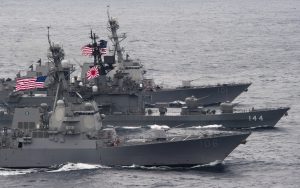The National Security Strategy and the two accompanying documents, released by the Japanese Government in December 2022, represent the country’s deepening strategic thinking and the resultant transformation of its defense policy in particular. As widely reported, the three documents place particular emphasis on a new plan to acquire “stand-off” missiles that will constitute a core element of Tokyo’s “deterrence by denial and cost-imposition” (Ken Jimbo) vis-à-vis Beijing, along with the enhanced resilience of Japanese bases, more robust intelligence, and other new capabilities.
Tokyo aims to ensure that, even in the event of massive strikes by the massive arsenal of the People’s Liberation Army (PLA) (a nucleus of its anti-access/area-denial (A2/AD) strategy), surviving SDF units would remain capable of conducting their own strike operations to, for example, take down the PLA’s amphibious forces and even targets inside Chinese territory. Through these measures to deny any potential attempt by Beijing to alter the Japanese territorial status quo, the three documents declare that Japan will assume “the primary responsibility” for defending itself even against a far more powerful China.
Crucially, this new defense policy, as outlined in the documents, is not only reshaping the SDF’s capabilities and Japanese government’s security system, but also changing the country’s Indo-Pacific policy by injecting strategic thinking and creating new security instruments. The links between the defense and Indo-Pacific policies are particularly salient in three contexts.
First, the alliance with Washington, a pillar of Tokyo’s Indo-Pacific policy, is transforming in reflection of Japan’s emerging resolve and capacity to act. When it comes to long-range strike missions, for example, the two allies’ coordination at present can only be a one-way street in which Japan, without relevant capabilities, requests the United States to conduct operations to strike distant targets. As a result of Japan having its own strike options, the alliance is seeking to build more interactive coordination processes in which Tokyo has a greater say and capabilities to offer. Moreover, Japan’s increasing capacity to absorb, survive, and degrade the PLA’s A2/AD capabilities mean that U.S. military operations in the Far East may become more visibly dependent on a strengthened SDF and Tokyo’s strategic decisions. It should be noted that the building of this kind of interactive coordination and cooperation between the two militaries is far from a guaranteed result given that Japan declines to come under a U.S.-led combined command structure like NATO and the US-Korea Alliance.
Second, the three documents envisage that Japan is becoming more resolved and equipped to promote what can be termed “tailored networking” with other Indo-Pacific players. At the most basic level, the consolidation of Japan’s military strategy to defend itself is preparing Tokyo to engage in deeper security discussions and strengthen its relations with other Indo-Pacific partners to keep China’s strength in check. This is an obvious boost, for example, for the Japan-Australia relationship in light of the two countries’ late 2022 security declaration, in which they committed to consult with each other on security emergencies, a pledge reminiscent of the ANZUS treaty. The new National Security Strategy and accompanying two documents also envisage that Japan is going to have new tools to strengthen relations with many other partners, both through the relaxation of restraints upon Japan’s arms exports being considered and new security assistance budgets beyond the existing foreign aid protocols. The former has a direct bearing on Japan-U.K.-Italy joint development of a fifth-generation fighter while the latter will be an instrument for promoting ties with, for example, Southeast Asian states. By advancing such “tailored networking,” Japan seeks to reinforce a regional picture in which its strategy and defense build-up are not stand-alone efforts but a part of promoting what the three documents conceptualize as a “new balance” even under the shadow of a powerful China.
Third, Japan is promoting what it dubs a “constructive and stable relationship” with China. The word “constructive” suggests that Japan and China should focus on cooperating where they can even if the two countries have problems in other issue areas. “Stable” signals that existing problems should be prevented from leading to an unwelcome eventuality. This is by no means hollow rhetoric. As the three documents note, Japan’s resolve to accept the primary responsibility for its own defense and its unprecedented defense build-up are expected to “bolster the solid footing of Japan’s diplomacy”; in other words, its efforts to manage tensions with China by foreclosing any other options for Beijing but to co-exist with a newly formidable Japan.
Amongst many challenges for promoting these three sets of Indo-Pacific relations, the most complex is the management of their inevitable interrelations. Depending on how Japan works these out, it could face a positive or negative circle. For instance, the introduction of Japan’s greater strategic thinking into the relationship with the United States may help Japan promote its relations with other players such as India, which tend to welcome Japan’s greater agency as a security actor, while the alliance itself continues to attract Australia as a close partner. Moreover, the visible promotion of a Japan-China relationship can make Tokyo a more sure-footed partner for many regional states which choose to live with and benefit from China and thus facilitate Japan’s relationship-building, for example with Southeast Asian countries. If these relations were to go awry, it may become harder to achieve international conditions conducive to maximizing the intended effects of the defense policy in the long run. In this sense, Japan’s new defense policy is not only impacting its Indo-Pacific policy, but also vice versa.

































